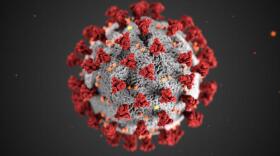January was the deadliest month during the pandemic in Nevada. More than 1,100 people statewide lost their lives. But, as we make our way through February, the state is starting to see a downward trend in cases and hospitalizations. KUNR’s Lucia Starbuck talks with an epidemiologist to learn what this recent decline means.
Lucia Starbuck: With us is Brian Labus, an epidemiologist with Nevada’s COVID-19 medical advisory team. So Brian, when we say, “Nevada is on a downward trend,” what does that mean exactly?
Brian Labus: Over the past month we’ve seen a slow but steady decline in the number of cases, the number of hospitalizations and the percent of people testing positive for COVID. We saw a plateau starting around Thanksgiving that lasted through the end of the year. And over the entire month of January we’ve seen those numbers slowly start to come down statewide. They started coming down a little, first in the Northern part of the state and a little later in the Southern part of the state, but we’ve seen continual declines throughout the state over the past month or so.
Starbuck: I’ve noticed the number of people hospitalized for COVID-19 has also dropped more than 500 patients in the last few weeks, is that what you’re seeing too?
Labus: The number of hospitalizations have declined because the number of people being infected with COVID have declined. As fewer people get infected we’ll see fewer hospitalizations. The one number that we really haven’t seen decline yet, is the deaths, and that is because it takes a couple of more weeks until the changes in our community are really reflected in the deaths. So, as we move through February we would expect to see the deaths decline as well, as long as those other numbers keep decreasing.
Starbuck: I was excited to see our test positivity rate has dropped about 5% since mid-January too.
Labus: It’s great to see that heading in the right direction as well. The only downside to that is we are still seeing a lot of transmission. So, it’s decreasing, it’s heading in the right direction, but in general, we’re still at a pretty high level when it comes to disease transmission in Nevada.
Starbuck: Do these numbers make you feel optimistic?
Labus: Well, I think we can enjoy our successes. The governor put a pause in our activities, we cut back on the number of people that could be in restaurants and events and things like that, and over the past month we’ve seen the effects of that. Our numbers are starting to head in the right direction. So yes, we can be happy about that, but we also can’t stop doing the things that we’ve been doing to make that happen.
Starbuck: Also, I feel like we [have] to talk about the vaccine rollout. I did see nearly 8% of Nevada’s population has received at least their first dose, how significant is that?
Labus: Early on in our vaccination programs, we’re focusing on the populations that are at highest risk of death and those that are essentially the infrastructure that we need to keep things running. This will help our state keep running in many ways because if we’re focusing on healthcare workers and teachers we can start to talk about reopening schools in the largest areas of the state, and we can have a health care system we’re not worried about collapsing when it gets overwhelmed with patients. We also may not see a change in the number of infections, but if we’re vaccinating the older population it may now skew toward younger people, which means we’ll see fewer deaths and fewer hospitalizations.
Starbuck: So now that we’re seeing some Nevadans get vaccinated, when do you think it’s going to start impacting our cases?
Labus: We’re nowhere near the numbers we need to, to really make a huge dent in transmission. We’re talking about a very small percentage of people in January that would have been vaccinated. It’s increasing every day obviously, but it takes two shots until you’re fully protected, and those shots come either three weeks or four weeks apart. So, we only started vaccinating people at the very end of December, which means they aren’t fully protected until the middle or end of January. It really isn’t going to have time yet to really make much effect on the transmission. Now that we’re into February, we’ll start to see hopefully reduced transmission to the groups that we’ve targeted, but those are just a small percent of the overall population of the state.
Brian Labus is an epidemiologist with Nevada’s COVID-19 medical advisory team.
Lucia Starbuck is a corps member with Report for America, an initiative of the Ground Truth Project.
KUNR's Olivia Ali adapted this story for the web.







